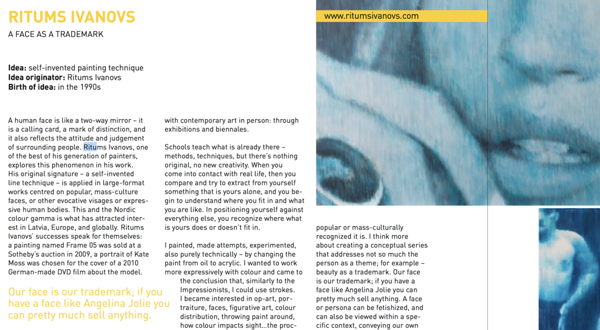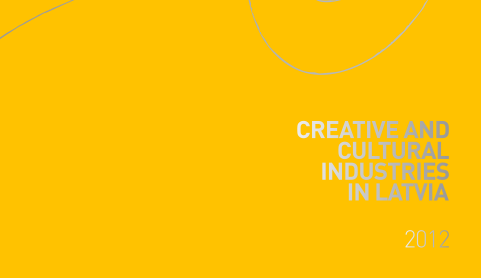Ritums Ivanovs and his master style were included into "
Creative and Cultural Industries in Latvia", a 2012 publication within the framework of the Central Baltic Sea Region INTERREG IV A programme and
SSE Riga, the Baltic leader in business education
RITUMS IVANOVS
A FACE AS A TRADEMARK
Idea: self-invented painting technique
Idea originator: Ritums Ivanovs
Birth of idea: in the 1990s
A human face is like a two-way mirror – it is a calling card, a mark of distinction, and it also reflects the attitude and judgement of surrounding people.
Ritums Ivanovs, one of the best of his generation of painters, explores this phenomenon in his work. His original signature – a self-invented line technique – is applied in large-format works centred on popular, mass-culture faces, or other evocative visages or expres- sive human bodies. This and the Nordic colour gamma is what has attracted interest in Latvia, Europe, and globally.
Ritums Ivanovs’ successes speak for themselves: a painting named Frame 05 was sold at a Sotheby’s auction in 2009, a portrait of Kate Moss was chosen for the cover of a 2010 German-made DVD film about the model.
"It seems that self-invented painting technique is an important and significant step, but in reality it is the result of a process. While I was studying we were isolated from Western Europe, and art history was more concentrated on classical art – contemporary art processes were not featured – that’s why the education was on the whole quite classical. I needed to further my studies in America and take a practical approach in getting acquainted with contemporary art in person: through exhibitions and biennales.
Schools teach what is already there – methods, techniques, but there’s nothing original, no new creativity. When you come into contact with real life, then you compare and try to extract from yourself something that is yours alone, and you be- gin to understand where you fit in and what you are like. In positioning yourself against everything else, you recognize where what is yours does or doesn’t fit in. I painted, made attempts, experimented, also purely technically – by changing the paint from oil to acrylic. I wanted to work more expressively with colour and came to the conclusion that, similarly to the Impressionists, I could use strokes. I became interested in op-art, por- traiture, faces, figurative art, colour distribution, throwing paint around, how colour impacts sight...the process of the fusion of these various things resulted in the self-invented technique.
I found similar stylistic traits in several artists who have their own school and followers; in getting to know them I had to cast aside their methods. One must take one’s own path. I’m interested in the face as a human’s means of expression, and less so in how popular or mass-culturally recognized it is. I think more about creating a conceptual series that addresses not so much the person as a theme; for example – beauty as a trademark. Our face is our trademark; if you have a face like Angelina Jolie you can pretty much sell anything. A face or persona can be fetishized, and can also be viewed within a spe- cific context, conveying our own reflections on it. That’s the way conceptual selection is created. Thematically I haven’t concentrated on the personal; I’m interested in the socially objective view. Scanning what is happening around, what it looks like, images that speak to me. Mass culture is my field of interest. And the human at the centre of it."
About the project of the publication "Creative and Cultural Industries in Latvia 2012": published within the framework of the Central Baltic Sea Region INTERREG IV A programme 2007 -2013 project
CREAENT – Creative Entrepreneurship Training Network. The project was implemented by Aalto University (Finland), in cooperation with Tallinn Technological University, the University of Tartu (Estonia) and the Stockholm School of Economics in Riga (Latvia).
During the CREAENT project an analysis of the situation in creative entrepreneurship education was carried out, and a training programme for young creative entrepreneurs was created and piloted. In addition, several networking forums for creative entrepreneurs from Estonia, Finland, Latvia and Sweden were organised. To learn more about the project please visit www.creaent.fi.
Several companies that participated in CREAENT project events are included in this publication: Angel Glass Design, Arhiidea, ArtBag, DD Studio, Nabaklab, Mareunrol’s and the LNAM Brand fund.
About SSE Riga: Since 2007 SSE Riga has appeared in the Financial Times Ranking of European Business Schools. The School is ranked together with its 'mother', the Stockholm School of Economics (SSE), and its 'sister', the Stockholm School of Economics in Russia (SSE Russia).
According to the Financial Times Ranking of Top European Business School in 2011, SSE Riga is the Nr 1. business school in the Baltic/Nordic region.
Text by Agija Krasta
Translation into English by Sarma Gaide
Design by Dripe dizains


